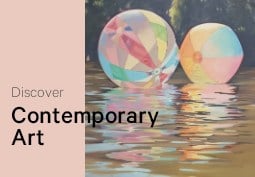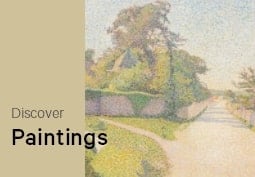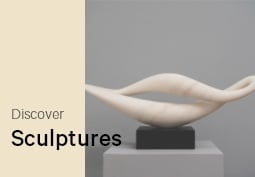Interviews
Artland Interviews: Sophie Neuendorf
The Vice President of Artnet on Growing Up in the Art World, Innovation in the Art Market, and the Power of List-Making
“I’ve seen several different sides of the market…and that’s quite valuable.”
Sophie Neuendorf
In an exclusive interview with Artland Magazine, Sophie Neuendorf, Vice President of Artnet, shared her unique journey through the art world – a blend of heritage and innovation. From the quiet of the Spanish countryside, she took a moment to reflect on her multifaceted career and her trajectory in the art world, rooted in a lifetime of experiences, familial legacy, and a deep commitment to fostering artistic talent.
A Legacy Born into Art
Sophie’s introduction to the art world was nothing short of organic. “I feel like I’ve been born into the art world,” she remarked, recounting her father’s initial ventures as an art dealer in Hamburg. Her early memories include mingling with prominent figures like Leo Castelli and being surrounded by works from the likes of Warhol and Lichtenstein. This upbringing was not merely about exposure; it instilled in Sophie a nuanced comprehension of both the creative and commercial facets of the art market.
The family’s move to New York when her father, Hans Neuendorf, founded Artnet further immersed her in the industry’s heartbeat. Her career trajectory took her through various roles. From interning at Christie’s early on in her career to pivotal positions at Artnet, including Gallery Network and Partnerships Director and her current role as Vice President, Sophie experienced different angles of the art industry. “I’ve seen several different sides of the market…and that’s quite valuable. It’s been very helpful for my life today,” she noted.
The Neuendorf Residency
Among her numerous responsibilities, Sophie takes pride in the Neuendorf Residency in Mallorca, a project that further adds to the Balearic islands’ thriving art scene. “We wanted to create something of value,” she explained. The residency was born out of a desire to keep their family summer house alive and soulful while also providing support to emerging artists. By converting an extra building into a studio, the Neuendorf family established a haven where creativity could flourish inspired by the Mediterranean land and seascape and the striking minimalist architecture specially designed by John Pawson and Claudio Silvestrin for the Neuendorf family in the late ‘80s.
Setting up his temporary studio at the Neuendorf House this year is William Monk, but the residency has already hosted several notable artists, including Louise Giovanelli, Christine Safa, and Nathanaëlle Herbelin, whose work was featured this spring at the Musée d’Orsay as part of the museum’s project dedicated to emerging artists who are gaining critical acclaim. “The synergies were just amazing,” Sophie said, highlighting the collaboration between the residence, the artists, their galleries, and Artnet News, which supports the project and the artists editorially to help bridge the gap between art creation and market engagement.
“One thing that you have that nobody can ever take away from you is your knowledge. And then when you have that, my advice is to give it back.”
Sophie Neuendorf
Balancing Roles: Teaching and Leadership
Beyond her executive role at Artnet, Sophie is also a professor at IE University in Madrid. “They wanted the angle that I was passionate about: the intersection between art and finance,” she shared. Her goal is to demystify the art market’s complexities for her students, emphasizing the importance of data-driven decision-making and understanding art as both a cultural and financial asset.
Sophie’s commitment to education extends her influence, preparing the next generation to navigate the art world with a balanced view of passion and practicality and debunking the misconceptions about the art world being all exhibition openings and champagne. “There’s a lot of career opportunities in the art world for people studying business… not only as gallerists,” she noted. “The amount of people knowledgeable about art and finance and business is still relatively limited, but that’s something that’s going to be more asked for in the future. So that’s the kind of knowledge I want to give them.”
Managing her extensive responsibilities requires meticulous organization. When asked how she juggles her diverse array of projects and her busy schedule, she revealed her inclination toward list-making and setting reminders on her phone. The rest is just about prioritizing and organizing effectively. “It’s a bit of the work smarter, not harder thing,” she said.
In an industry that is still predominantly male-dominated, Sophie’s journey has not been without challenges. She explained how she often felt underestimated at the beginning of her career – although this turned into an opportunity sometimes, “you overdeliver against expectation,” she reflected. Her advice to young women aspiring to leadership roles is to invest in one’s own education and training to be able to understand as many aspects as possible of an art business, not only the art part. “One thing that you have that nobody can ever take away from you is your knowledge. And then when you have that, my advice is to give it back.” Her recommendation comes from experience as she has expanded on her education with courses on executive finance, ESG reporting, global politics and economics, and now sits in two boards.
A Vision for the Future
While initiatives like the Neuendorf Residency show the commitment to fostering and supporting artistic talent, Sophie’s vision for the future seems to involve a more sustainable and dynamic art world where business acumen and artistic passion coexist harmoniously.
Looking ahead, Sophie sees the art market evolving, with a greater emphasis on transparency and data. Tokenization is a valuable solution, she says, if adopted widely. “Gallerists, above all, need to understand that it’s in their best interest to have this type of transparency.”
Experience has taught her that the art industry can be slow to adapt to innovation. She recalls times when forward-thinking initiatives, such as online auctions, were launched ahead of their time but were only fully embraced by the art world years later. “Sometimes the art market just needs time to catch up,” she says.
Relevant sources to learn more
More articles from Artland Magazine you may like:
In Conversation With Leading Art Market Expert and Best-Selling Author Magnus Resch
David Shrigley: “Do What You Want to Do, Try Not to Get Bored”
Interview with Mary Rozell, Global Head UBS Art Collection
Other relevant sources:
The Neuendorf Residency





